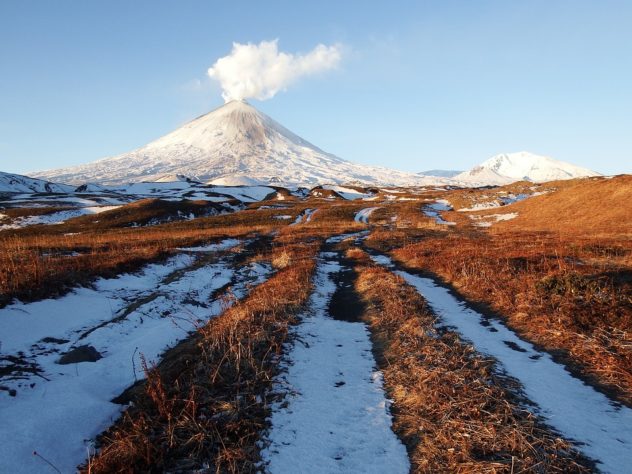Vocabulary:
- hazard /HAZ-erd/
- solidify /suh-LID-uh-fahy/
- stratovolcano /strat-oh-vol-KEY-noh/
- Eurasia /yoo-REY-zhuh/
- seismic /SAHYZ-mik/
[noun] something that is dangerous and likely to cause damage
The increasing levels of pollution poses a great hazard to the locals’ health and the environment.
[verb] to change from being a liquid or gas to a solid form
Thick flow lava takes years to decades for it to solidify.
[noun] a large, steep volcano built up of alternating layers of lava and ash or cinders
Stratovolcanoes are considered the most dangerous type of volcano due to their steep structure.
[noun] Europe and Asia considered together as one continent
Several countries are part of Eurasia, but the most well-known is Russia.
[adjective] relating to or caused by an earthquake
The researchers were able to detect seismic waves from the upcoming tsunami.
Klyuchevskoy, the highest volcano in Russia, erupted on March 2 this year. As reported by the Kamchatka Volcanic Eruption Response Team (KVERT) on the same day, Klyuchevskoy had been spewing ash and steam 20,000 feet in the air. The KVERT also mentioned that several emissions of ash approximately 16,400 to 23,000 feet may take place at an indefinite date and time. The said eruption was classified as orange based on the aviation color code, which indicates that the volcanic ash formed from the eruption has a potential hazard that may affect flights. According to the United States Geological Survey (USGS), the ash particles can damage the navigation equipment of aircraft once they are absorbed and re-solidified inside the engines.
Klyuchevskoy is a stratovolcano located in the Kamchatka Peninsula of East Russia. It is the most active volcano in Eurasia with a height of 15,580 feet, and is speculated to have an estimated age of 7,000 years. The volcano is part of the Klyuchevskaya group, where 160 more volcanoes can be found. 26 out of the mentioned number of volcanoes are noted to be active, and researchers discovered seismic activity surrounding one of the restless volcanoes last 2019.
Klyuchevskoy is a stratovolcano located in the Kamchatka Peninsula of East Russia. It is the most active volcano in Eurasia with a height of 15,580 feet, and is speculated to have an estimated age of 7,000 years. The volcano is part of the Klyuchevskaya group, where 160 more volcanoes can be found. 26 out of the mentioned number of volcanoes are noted to be active, and researchers discovered seismic activity surrounding one of the restless volcanoes last 2019.
True or False:
- The ash cloud from the volcanic eruption is considered safe to airplanes.
- There are 160 volcanoes in the Klyuchevskaya group.
- Klyuchevskoy is believed to be 7,000 years old.
- Klyuchevskoy’s eruption is listed as red according to the aviation color code hazard.
- The KVERT group reported that Klyuchevskoy had been emitting steam 20,000 feet in the air.
Discussion Questions:
- In your opinion, what do you think will be the effect of the volcanic eruption on Russia’s environment and health status of its residents? Please explain your answer.
- Do you suppose the remaining active volcanoes in the peninsula mentioned in the article will also cause a threat to the locals? Why or why not?
- Are there any active volcanoes in Japan? Kindly enumerate the names and their locations.
- What are the usual natural calamities that take place in Japan?
- What precautions can we take in preparation for any volcanic eruptions?
Express Your Opinion:
- Natural disasters cannot be avoided or prevented.
- We must always rely on our advancing technology to recover from any natural calamity.
- “Safety brings first aid to the uninjured.” – F.S. Hughes
